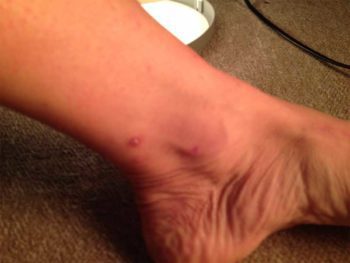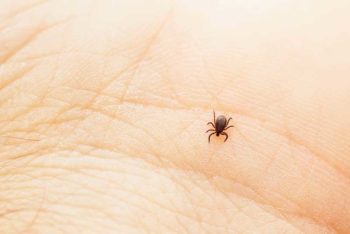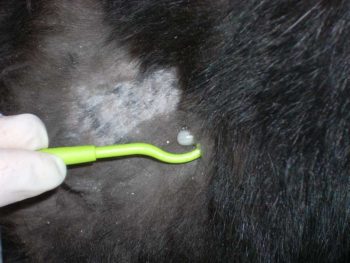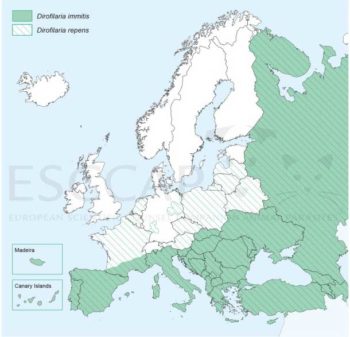17 Aug 2023
Possible effects of climate on UK pet parasites and their control
Ian Wright BVMS, BSc, MSc, MRCVS discusses the impact of the UK’s weather conditions on both the establishment and spread of parasites.

Image: © Dima Anikin / Adobe Stock

A strong consensus exists that climate change is occurring and, as it is at least partly attributable to greenhouse gas emissions from human activity, we can expect further warming to occur.
Some parasites of veterinary and zoonotic significance in the UK are unlikely to be affected by global warming. Toxocara species are ubiquitous and transmitted by routes largely sheltered from environmental changes (transplacental, transmammary, numerous paratenic hosts and environmentally resistant eggs).
Others, such as some tapeworms, are transmitted through the ingestion of meat and offal from domestic livestock, with the intermediate host being largely unaffected by gradual changes in climate.
Other parasites, however, depend heavily on warmth and humidity to reproduce, feed and survive. Angiostrongylus vasorum, Ixodes ticks and fleas are all examples of parasites where climate might be expected to have impact with increased transmission occurring.
Increasing periods of warm weather also allow novel vectors to establish that might transmit new parasites, or allow exotic parasites to establish in existing UK vectors – Thelazia callipaeda and Dirofilaria immitis are prime examples of parasites where these factors may come into play in the UK.
Fleas
Temperatures below freezing are lethal to adult cat fleas, dying within five days at -1°C and 10 days at 3°C. Survival significantly increases when temperatures exceed 8°C, where nearly half of emerged adults stay alive for 20 days (Silverman and Rust, 1983).
Eggs and larvae are also highly susceptible to cold temperatures, with larvae dying 10 days post-hatching at 10°C (Silverman et al, 1981).
The effects of cold temperatures in winter are somewhat offset by the protection to adult fleas afforded by the fur of their host and centrally heated homes. This means that infestations can occur at any time of year, but a milder winter temperature means that other life stages can continue to survive and develop.
Temperatures in the 20°C to 27°C range are particularly favourable to fleas, and climate change leading to persistently high humidity is also thought to be a driving factor in countries where fleas are spreading rapidly, such as Australia (Crkvencic and Slapeta, 2019). Therefore, a warming climate and overall trend of milder, wetter seasons is likely to support increasing flea numbers and frequency of infestations on pets.

Fleas are highly prevalent on domestic UK cats and dogs, with 28.1% of cats and 14.4% of dogs found to be infested in the UK (Abdullah et al, 2019). The vast majority of fleas on cats and dogs are cat fleas, which are highly adaptable, living in domestic homes on a wide range of hosts. Without routine preventive treatment, a high risk exists of flea infestations establishing (Coles and Dryden, 2014).
Fleas are a cause of allergic dermatitis and vectors for a variety of infections, including Bartonella henselae (the cause of cat scratch disease), Rickettsia felis (the cause of spotted fever), Haemoplasma species (the cause of feline infectious anaemia) and Dipylidium caninum tapeworms, and 11.3% of flea infestations on UK cats and dogs have recently been found to be positive for Bartonella species (Abdullah et al, 2019).
People are thought to be exposed to this pathogen primarily through flea faeces, making flea control vitally important for preventing zoonotic exposure. Cat fleas also remain a significant cause of dermatitis in cats and dogs, and a source of irritation and revulsion to owners (Figure 1).
The increased risk of disease transmission and household infestation establishing makes year-round flea control vitally important. Household infestations may establish through the winter via the mechanical transmission of newly emerged adults into the home. Even households with purely indoor cats may be infested by owners triggering outdoor pupal emergence through their heat and movement, and then bringing newly emerged adults inside on clothing.
Once inside, these adults can feed on indoor cats and infestation is established. In a similar fashion, cats visiting multiple households may be infested and then bring fleas into a number of different homes.
The most important aspect of flea control is to ensure adult fleas are killed on the pet before they can initiate egg production. Treatment of the environment with insect growth regulators, environmental insecticides, hot washing of bedding and daily vacuuming is also important to reduce environmental larvae and eggs.
Reducing pupal numbers in the environment is difficult; however, making effective, rapid killing of adults is essential. To effectively prevent flea reproduction a flea adulticide product must:
- Kill close to 100% of fleas – if any fleas are not killed, reproduction and egg laying will continue.
- Achieve flea kill quickly enough to prevent egg laying – treatment efficacy is not sufficient if the fleas are able to reproduce before they are killed. Adult fleas can lay eggs within 24 hours, so effective adulticides must kill fleas at least within that time.
- Be applied often enough to continue to prevent egg laying. The time after application at which fleas survive long enough in the presence of the product to lay eggs is known as the “reproductive break point”. If the reproductive break point is reached then flea control will fail.
- Maximise compliance – through discussing with clients whether they would prefer a spot-on, tablet or collar preparation, and establishing whether a systemic product might be beneficial if the pet frequently swims or is shampooed.
Ixodes species ticks in the UK
Ixodes species ticks are endemic in the UK and carry a range of pathogens, including Borrelia species (the cause of Lyme disease), small babesias, Anaplasma phagocytophilum and tick-borne encephalitis virus.
Seasonal peaks in tick activity occur in the spring and autumn months. Climate change has led to increased activity in the summer, with the potential for tick exposure at any time of year (Abdullah et al, 2016; Wright et al, 2018) providing potential exposure of dogs and people to tick-borne pathogens throughout the year.
A continuing milder climate, however, will favour an increasing tick population and increased tick activity throughout the year, increasing the risk of pathogen exposure to both pets and people.
Veterinary professionals, when advising clients, should be aware that while tick questing and attachment is at its greatest during spring, summer and autumn, pets and their owners may be exposed all year round.
Pets, therefore, that have lifestyles that put them at high risk of tick exposure will require year-round prevention. This includes walking off path in rural areas, rough pasture or land used by deer or ruminants.
A history of previous tick attachment may also exist and many cats will also be exposed to repeated infestations.
Tick preventive measures include:
- A preventive product that will rapidly kill or repel ticks. No tick preventive product is 100% effective, but use of isoxazoline or pyrethroid-containing products are highly efficacious, and will reduce disease transmission.
- Check for ticks on pets every day, removing any ticks with a tick removal device, such as a tick hook (Figure 2). Squashing or crushing ticks in situ with blunt tweezers or fingers will stress the tick, leading to regurgitation and emptying of the salivary glands – potentially leading to increased pathogen transmission. Traditional techniques to loosen the tick, such as the application of petroleum jellies or burning, will also increase this likelihood and are contraindicated.
- Where possible, sticking to paths without vegetation will minimise tick exposure risk. People can also protect themselves by wearing long sleeves and tucking trousers into socks or boots. Pyrethroid washes for clothes, pre-prepared pyrethroid impregnated clothes, DEET and citronella are also available for some additional human protection. The body should be carefully inspected for ticks after being outdoors and any ticks found removed, as described for pets.
Angiostrongylus vasorum
Angiostrongylus vasorum has been spreading north throughout the UK over the past two decades.
Climate change is thought to have had relatively little direct influence on this spread, as temperature and humidity in the UK has long been sufficient to support parasite transmission and an abundance of slug intermediate hosts.
Increased movement of dogs around the country is thought to be a major factor driving spread, but increases in temperature and humidity are likely to have led to increased periods of activity for slugs. This allows greater opportunity for dogs to encounter them and ingest them.
A vasorum has spread rapidly from endemic foci in Wales and the south-west of England, across the whole of the UK. Increased reporting of cases has been seen in domestic dogs, with 20% of practices across the country having seen at least one case over a 12-month period (Kirk et al, 2014).
To establish if this perceived spread and increasing number of cases was genuine, postmortem examination surveys were carried out on foxes in 2005 (Morgan et al, 2008) and in 2014 (Taylor et al, 2015), which act as wildlife reservoirs.
The overall prevalence rose from 7% to 18% in foxes during this period and extended to regions previously clear of infection, such as northern England and Scotland.
The spread of A vasorum is, therefore, genuine, but not uniform, with focal areas of very high prevalence and other areas remaining free of infection. Case reporting sites have been useful in mapping areas of high prevalence and the introduction of A vasorum into new areas. Reporting of cases is only voluntary, however, and distribution of infection very fluid.
Dogs at high risk of exposure should be placed on a licensed routine preventive treatment containing moxidectin or milbemycin oxime. This includes dogs that deliberately eat slugs and snails, and those that may accidentally ingest them though consumption of grass and coprophagia.
In areas known to be endemic foci, then monthly preventive treatment should be seen as routine – especially prior to surgery.
In areas where endemic status is less certain than testing of dogs prior to surgery, suspected cases and annual testing of young dogs will rapidly build up a picture of whether A vasorum is endemic in an area. This data accumulation is vital if risk-based advice is going to be given and this needs to be constantly updated, as the regional prevalence of A vasorum can be very fluid.
Thelazia callipaeda
Thelazia callipaeda, also known as the “oriental eye worm”, is a zoonotic vector-borne nematode that resides in the conjunctival sac of definitive hosts such as carnivores, rabbits and humans (Mihalca et al, 2015).
The parasite is found widely in Asia and has been spreading through Europe in recent years.
The vector in Europe is the drosophilid fruit fly, Phortica variegata. The intermediate host fly ingests L1 larvae from a definitive host while feeding on lacrimal secretions from the eyes.
L1 larvae then develop over a period of 14-plus days to L3 larvae, which are deposited in a new host when feeding and mature in the conjunctival sac (Graham-Brown et al, 2016).
Although often non-pathogenic, ocular thelaziosis can commonly cause conjunctivitis, keratitis, epiphora, eyelid oedema, corneal ulceration and, in serious cases, blindness.
T callipaeda was first reported in Europe in Italy and since 2007 autochthonous cases have spread east and northwards. This spread is due to a combination of increased movement of dogs throughout Europe and the expanding distribution of Phortica fruit flies.
In 2016, the UK saw its first case of ocular thelaziosis in a dog imported from Romania six weeks previously (Graham-Brown et al, 2016) and Phortica variegata is spreading through southern Europe (Morgan, 2016).
This presents the possibility of UK establishment, and rapid identification and treatment of imported cases is vital to minimise this risk.
Dirofilaria immitis
Dirofilaria immitis is a filarial heartworm primarily of canids, but also can infect ferrets and felids.
It is endemic throughout southern, eastern and parts of central Europe (Figure 3), and is a significant cause of cardiopulmonary disease.
Transmission occurs through feeding by a wide range of mosquito species present throughout Europe, including the UK.
The climate in northern and parts of central Europe has been too cold to allow D immitis to complete its life cycle in the mosquito, but climate change – in combination with increased movement of pets and people throughout Europe – is allowing the parasite to spread.
As temperatures rise, the potential for temporary or even permanent endemic foci to be established in the south of the UK increases.

Early identification and treatment of D immitis improves outcomes for infected pets, but as the climate warms will also form a key part of avoiding this parasite becoming endemic in the UK.
Conclusions
A mild, humid climate in the UK is beneficial for many parasites to feed, reproduce and increase their geographical distribution.
This has rightly led to increased concern regarding the establishment of parasites not previously endemic in the UK and the potential for endemic parasites to spread. These changes need to be considered when formulating parasite control programmes.
Surveillance is also vital to diagnose exotic parasites in imported and travelled pets early, and identify potential endemic foci before further spread occurs.


